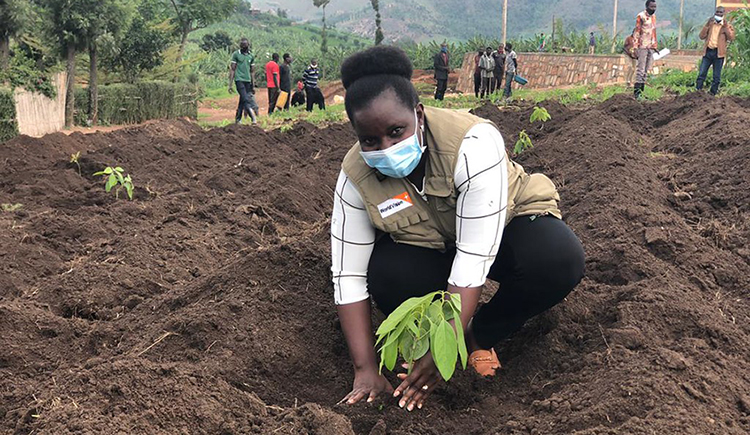World Vision Rwanda through its partnership with the Regreening Africa and Forest Landscape Restoration projects has committed to plant a total of 7,695,300 trees throughout the 2020/21 tree planting season to address climate change and improve livelihoods.
In line with the national theme for the tree planting season, ‘Forests for Community Livelihood and Sustainable Development’, and in an effort to contribute towards the government’s target of planting 25 million trees, the organisation held a tree planting event in Nyagatare District on Friday, Nov. 13, 2020, to create awareness on the challenges of land degradation and the need for land restoration initiatives.
The Regreening Africa Project funded by the European Union (EU) and the Forestry Landscape Restoration (FLR) project funded by the Australian government through its Department of Foreign Affairs and Trade (DFAT) and World Vision with technical support from World Agroforestry (ICRAF), together support farmers to improve their livelihoods.

Delegates from Rwanda Forestry Authority, Nyagatare District, representatives from World Vision, ICRAF, Rwanda Agriculture Board (RAB) and other implementing partners joined residents and farmers in Nyagatare District to plant several types of trees and other multipurpose agroforestry trees in Gishuro IDP Model Village, Gishuro Cell, Tabagwe Sector. Present at the event was also Pascal Zahonero, a European Union delegate.
Precisely 7,100 agroforestry trees, which include 4,100 fruit trees, were planted in the model village that accommodates 64 vulnerable families since July.
Last year, the Christian humanitarian organisation through the two projects planted more than six million tree seedlings whilst facilitating local community participatory approaches in tree seedlings production, capacity building in various agroforestry and land restoration practices to enhance agricultural productivity.

“World Vision works to ensure children live in a safe and conducive environment that enables them to fulfil their potential. The impact of climate change leaves vulnerable children most exposed” said the National Director of World Vision Rwanda, Sean Kerrigan.
“Participating in activities that conserve the environment such as tree planting and training farmers on sustainable agricultural practices that enhance soil fertility is one of the ways to reduce climate shocks as well as to support the livelihoods of families that depend on farming” he added.
Adele Mukamunana, who is in her late 70s, is one of 64 families living in the model village, where she lives with five grandchildren. She expects to start eating fruits from their own trees in two years since they just planted grafted seedlings.
She said: “It has been long since I ate an avocado or papaya, but we are certain that we will soon when these trees mature. Fruits are really important to our health, especially to these grandchildren.”

“We are really grateful for what we were given,” she added.
Nyagatare District Vice Mayor in charge of Economic Development, Stephen Rurangwa, commended the partnership that promotes the environment, explaining that the district needs more trees and forests due to its climate.
“A few years ago, we could not get rain on time, people wondered what could have happened, but we the people are the reason, when we do not preserve the environment, it leads to climate crisis, which affects us and our activities such as agriculture, and it affects our future as well,” he declared.

He said people should commit to leave the world a better place for future generations by protecting the environment.
“These fruits will promote good nutrition for families, healthy growth for children, as well as improved incomes for the households,” Rurangwa added.
Dismas Bakundukize, Director for the Forest Management Unit in Rwanda Forestry Authority, said World Vision’s “commendable” activity complements the Government programmes.
“This is a model village, a programme for proper settlements, however, the settlements are not complete if there are no trees. The trees will protect the village from winds, will provide shade from the sun and will make the place more attractive,” he explained.

The agroforestry trees can provide livestock feed, cooking fuel, but most importantly, the fruits can improve nutrition, he reiterated.
Trees still play a huge role in cooking in Rwanda, since the current NISR statistics show that 79 percent of the population use firewood as a source of fuel.
However, the figures show that more forests are located in Western Province on Congo-Nile Crest, with 42 percent of the land covered by forests.
In Eastern Province, on the other hand, it is 5 percent, “in the province, there is not enough space to plant forests, that is why we have chosen to plant agroforestry trees that can be grown in crops and pasturelands,” Bakundukize stated.

The official said that the ideal is 150 trees of agroforestry trees per hectare, and by 2024, Rwanda’s goal is that 85% of all farms will be covered by agroforestry trees.
In Eastern Province, the trees provided by World Vision Rwanda will be planted in the districts of Gatsibo, Nyagatare, Kayonza and Bugesera. The trees will include different species to address the various household needs such as fruits, fodder, soil fertility, firewood, erosion control and many others.



About Regreening Africa
Regreening Africa is an ambitious five-year project that seeks to reverse land degradation among 500,000 households, and across 1 million hectares in eight countries in Sub-Saharan Africa. By incorporating trees into croplands, communal lands and pastoral areas, regreening efforts make it possible to reclaim Africa’s degraded landscapes.
This story was produced with the financial support of the European Union. Its contents are the sole responsibility of Regreening Africa and do not necessarily reflect the views of the European Union.

